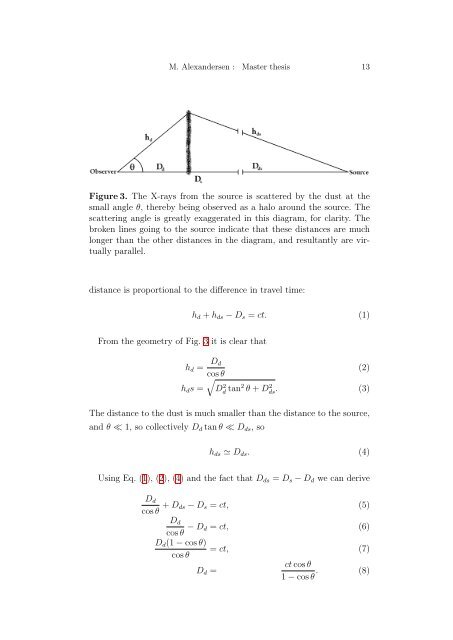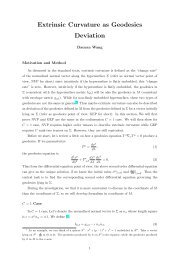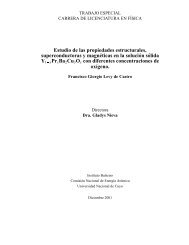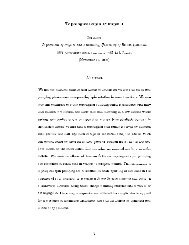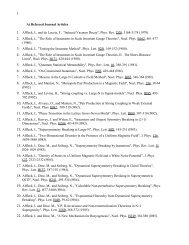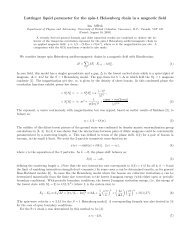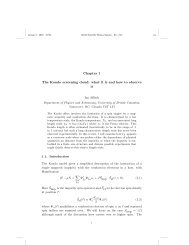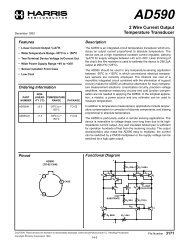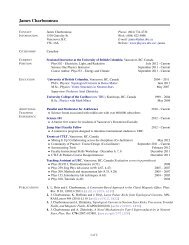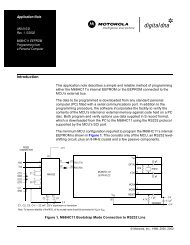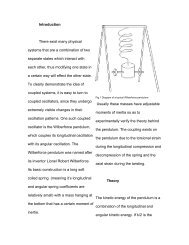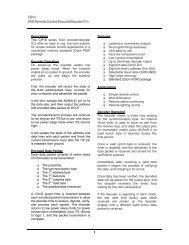- Page 1 and 2: An almost automated search for dust
- Page 3 and 4: M. Alexandersen : Master thesis 3 C
- Page 5 and 6: M. Alexandersen : Master thesis 5 G
- Page 7 and 8: M. Alexandersen : Master thesis 7 3
- Page 9 and 10: M. Alexandersen : Master thesis 9 F
- Page 11: M. Alexandersen : Master thesis 11
- Page 15 and 16: M. Alexandersen : Master thesis 15
- Page 17 and 18: M. Alexandersen : Master thesis 17
- Page 19 and 20: M. Alexandersen : Master thesis 19
- Page 21 and 22: M. Alexandersen : Master thesis 21
- Page 23 and 24: M. Alexandersen : Master thesis 23
- Page 25 and 26: M. Alexandersen : Master thesis 25
- Page 27 and 28: M. Alexandersen : Master thesis 27
- Page 29 and 30: M. Alexandersen : Master thesis 29
- Page 31 and 32: M. Alexandersen : Master thesis 31
- Page 33 and 34: M. Alexandersen : Master thesis 33
- Page 35 and 36: M. Alexandersen : Master thesis 35
- Page 37 and 38: M. Alexandersen : Master thesis 37
- Page 39 and 40: M. Alexandersen : Master thesis 39
- Page 41 and 42: M. Alexandersen : Master thesis 41
- Page 43 and 44: M. Alexandersen : Master thesis 43
- Page 45 and 46: M. Alexandersen : Master thesis 45
- Page 47 and 48: M. Alexandersen : Master thesis 47
- Page 49 and 50: M. Alexandersen : Master thesis 49
- Page 51 and 52: M. Alexandersen : Master thesis 51
- Page 53 and 54: M. Alexandersen : Master thesis 53
- Page 55 and 56: M. Alexandersen : Master thesis 55
- Page 57 and 58: M. Alexandersen : Master thesis 57
- Page 59 and 60: M. Alexandersen : Master thesis 59
- Page 61 and 62: M. Alexandersen : Master thesis 61
- Page 63 and 64:
M. Alexandersen : Master thesis 63
- Page 65 and 66:
M. Alexandersen : Master thesis 65
- Page 67 and 68:
M. Alexandersen : Master thesis 67
- Page 69 and 70:
M. Alexandersen : Master thesis 69
- Page 71 and 72:
M. Alexandersen : Master thesis 71
- Page 73 and 74:
M. Alexandersen : Master thesis 73
- Page 75 and 76:
M. Alexandersen : Master thesis 75
- Page 77 and 78:
M. Alexandersen : Master thesis 77
- Page 79 and 80:
M. Alexandersen : Master thesis 79
- Page 81 and 82:
M. Alexandersen : Master thesis 81
- Page 83 and 84:
M. Alexandersen : Master thesis 83
- Page 85 and 86:
M. Alexandersen : Master thesis 85
- Page 87 and 88:
M. Alexandersen : Master thesis 87
- Page 89 and 90:
M. Alexandersen : Master thesis 89
- Page 91 and 92:
M. Alexandersen : Master thesis 91
- Page 93 and 94:
M. Alexandersen : Master thesis 93
- Page 95 and 96:
M. Alexandersen : Master thesis 95
- Page 97 and 98:
M. Alexandersen : Master thesis 97
- Page 99 and 100:
Figure 42. DDD for 10 GRBs. M. Alex
- Page 101 and 102:
Figure 44. DDD for 10 GRBs. M. Alex
- Page 103 and 104:
Figure 46. DDD for 10 GRBs. M. Alex
- Page 105 and 106:
Figure 48. DDD for 10 GRBs. M. Alex
- Page 107 and 108:
M. Alexandersen : Master thesis 107
- Page 109 and 110:
M. Alexandersen : Master thesis 109
- Page 111 and 112:
M. Alexandersen : Master thesis 111
- Page 113 and 114:
M. Alexandersen : Master thesis 113
- Page 115 and 116:
M. Alexandersen : Master thesis 115
- Page 117 and 118:
M. Alexandersen : Master thesis 117
- Page 119 and 120:
M. Alexandersen : Master thesis 119
- Page 121 and 122:
M. Alexandersen : Master thesis 121
- Page 123 and 124:
M. Alexandersen : Master thesis 123
- Page 125 and 126:
M. Alexandersen : Master thesis 125
- Page 127 and 128:
M. Alexandersen : Master thesis 127
- Page 129 and 130:
M. Alexandersen : Master thesis 129
- Page 131 and 132:
M. Alexandersen : Master thesis 131
- Page 133 and 134:
M. Alexandersen : Master thesis 133
- Page 135 and 136:
M. Alexandersen : Master thesis 135
- Page 137 and 138:
M. Alexandersen : Master thesis 137
- Page 139 and 140:
M. Alexandersen : Master thesis 139
- Page 141 and 142:
M. Alexandersen : Master thesis 141
- Page 143 and 144:
M. Alexandersen : Master thesis 143
- Page 145 and 146:
M. Alexandersen : Master thesis 145
- Page 147 and 148:
M. Alexandersen : Master thesis 147
- Page 149 and 150:
M. Alexandersen : Master thesis 149
- Page 151 and 152:
M. Alexandersen : Master thesis 151
- Page 153 and 154:
M. Alexandersen : Master thesis 153
- Page 155 and 156:
M. Alexandersen : Master thesis 155
- Page 157 and 158:
M. Alexandersen : Master thesis 157
- Page 159 and 160:
M. Alexandersen : Master thesis 159
- Page 161 and 162:
M. Alexandersen : Master thesis 161
- Page 163 and 164:
M. Alexandersen : Master thesis 163
- Page 165 and 166:
M. Alexandersen : Master thesis 165
- Page 167 and 168:
M. Alexandersen : Master thesis 167
- Page 169 and 170:
M. Alexandersen : Master thesis 169
- Page 171 and 172:
M. Alexandersen : Master thesis 171
- Page 173 and 174:
M. Alexandersen : Master thesis 173
- Page 175 and 176:
M. Alexandersen : Master thesis 175
- Page 177 and 178:
M. Alexandersen : Master thesis 177
- Page 179 and 180:
M. Alexandersen : Master thesis 179
- Page 181 and 182:
M. Alexandersen : Master thesis 181
- Page 183 and 184:
M. Alexandersen : Master thesis 183
- Page 185 and 186:
M. Alexandersen : Master thesis 185
- Page 187 and 188:
M. Alexandersen : Master thesis 187
- Page 189 and 190:
M. Alexandersen : Master thesis 189
- Page 191 and 192:
M. Alexandersen : Master thesis 191
- Page 193 and 194:
M. Alexandersen : Master thesis 193
- Page 195 and 196:
M. Alexandersen : Master thesis 195
- Page 197 and 198:
M. Alexandersen : Master thesis 197
- Page 199 and 200:
M. Alexandersen : Master thesis 199
- Page 201 and 202:
M. Alexandersen : Master thesis 201
- Page 203 and 204:
M. Alexandersen : Master thesis 203
- Page 205 and 206:
M. Alexandersen : Master thesis 205
- Page 207 and 208:
M. Alexandersen : Master thesis 207
- Page 209 and 210:
M. Alexandersen : Master thesis 209
- Page 211 and 212:
M. Alexandersen : Master thesis 211
- Page 213 and 214:
M. Alexandersen : Master thesis 213
- Page 215 and 216:
M. Alexandersen : Master thesis 215
- Page 217 and 218:
M. Alexandersen : Master thesis 217
- Page 219:
M. Alexandersen : Master thesis 219


